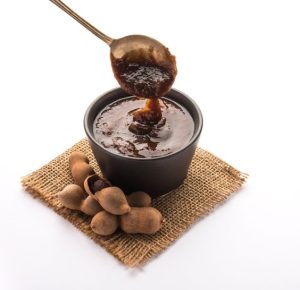
Running out of essential ingredients while preparing a dish is a common occurrence, and tamarind paste often falls into this category. However, there’s no need to panic as several viable alternatives can effectively replace it. Stay tuned to discover seven substitutes that work exceptionally well in such situations.
Tamarind paste, renowned for its delightful sweet, sour, and tangy essence, is a beloved kitchen staple. Crafted from tamarind, it features a pod-like structure housing seeds and a juicy, delectable pulp that forms the basis of tamarind paste.This versatile ingredient finds its way into soups, sauces, curries, and chutneys, imparting a distinctive citrusy flavor to dishes, particularly in Asian cuisine. If you’re fond of preparing Indian or Thai dishes, these fantastic alternatives can prove invaluable when your tamarind paste runs dry.
Let’s delve into the top substitutes for tamarind paste:
1. Lemon Juice and White Sugar: This blend replicates tamarind paste’s slightly sweet, tangy profile with a hint of citrus, offering a refreshing taste. Lemon provides tanginess, while sugar brings sweetness for a well-balanced substitute. A 1:1 ratio works best for optimal results.
2. Orange Juice: While not replicating tamarind paste’s exact flavor, orange juice contributes a citrusy touch and natural sweetness. It serves well in marinades, dressings, and glazes, but adjusting the quantity is crucial due to its inherent sweetness.
3. Pomegranate Syrup: A delightful alternative if available, pomegranate syrup mirrors tamarind paste’s consistency and flavor profile. Easily bought or homemade by combining sugar, lemon juice, and pomegranate, it complements curries and chutneys similarly to tamarind paste.
4. Cranberry Juice: Known for its sweet and tart flavor, cranberry juice works wonderfully in Thai cuisine and dishes requiring a sweet-sour balance. Ensure you’re aware of the sugar content in store-bought juices and consider diluting them for use.
5. Amchur Powder: Commonly used in Indian cuisine, amchur powder, derived from unripe mangoes, offers a tangy, sour taste reminiscent of tamarind paste. Create a paste-like consistency by adding water and use it in curries or chutneys in equal amounts as tamarind paste.
6. Kokum: A fruit frequently used in Indian cuisine, kokum possesses a tangy, sour, and sweet flavor akin to tamarind. Ideal for dishes like Rasam and Sambar that require tamarind or its paste.
7. Lemon Juice and Brown Sugar: Combining lemon juice and brown sugar serves as another substitute. Lemon adds a sharp flavor, while brown sugar provides a sweet balance. Use both in equal amounts to replicate a tamarind paste-like substitute.
Utilizing these alternatives allows you to carry on with your culinary endeavors seamlessly, ensuring that the absence of tamarind paste doesn’t hinder your culinary creativity.








